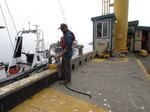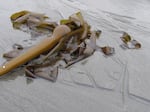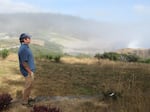Lisa Hildebrand studies gray whales. And the Oregon State University grad student is a huge fan.
“They’re super acrobatic,” she says. “We see them twist around, they do headstands, they swim on their sides.”
But the whales that come down to the southern Oregon Coast are part of an elaborate ecosystem, one reliant on a critical component: kelp.
For one thing, some of the whales’ prey, tiny shrimp called mysids, hide in kelp.
“The gray whales will blow a bubble blast underwater sometimes very close to kelp,” Hildebrand says, “and we’re not sure yet, but we think it’s to kind of scare the mysids, the zooplankton, out of the kelp and then the whales can easily just pluck them off.”
Related: ‘There aren’t a lot of other options:’ Port Orford’s season of crab and crisis
Scientists suspect that if there’s less kelp, potentially there could be fewer shrimp, which could mean fewer gray whales will come here to find them. And these days there’s less kelp. In some places along the Pacific Coast, a lot less. One study shows more than 90% of a kelp forest in Northern California was depleted in 2014.
To get a look at the state of local kelp beds, I went out with Dave Lacey. He’s the owner and guide at Southcoast Tours, a paddling and fishing tour company.

Dave Lacey prepares to launch his boat from the dock in Port Orford, Ore.
Kate Kaye / JPR News
He took me out on his boat this past August around the Port Orford Heads. They’re these massive boulders that dot the ocean near the rocky shore at Port Orford, about 60 miles from the California border.
So, out here, where researchers do their whale monitoring, there isn’t much left of a particular type of kelp that once flourished — bull kelp.
Lacey shows me a spot tucked in among those giant rocks called Nellie’s Cove. He says until fairly recently, the long stems and bulbs of bull kelp were plentiful — and the fishing was a lot better, too.
“Yeah, this is the last piece of kelp,” he says. “It was so thick in here when I started my business eight years ago that I wouldn’t drive my boat through a lot of it.”
A few things have occurred in recent years that have created what researchers call a perfect storm of poor kelp conditions.
Related: Saving Oregon’s rocky coast: Checking in on the sea stars
One: marine heatwaves — record high warm water disrupting the marine ecosystem of the West Coast. Kelp needs cold water to survive.
Another: a mysterious disease killed off sunflower sea stars, an important predator in the ecosystem where kelp lives. The sunflower sea stars eat sea urchins. Without them, the purple urchin population has exploded. And those urchins eat kelp. Because the urchin population is so out of whack, they’ve gobbled up way more than they normally would, leaving behind barren waters where kelp once thrived.

Bull kelp washed up on the shore of the Oregon Coast.
Kate Kaye / JPR News
“You can pick up a piece of kelp with four urchins on it and you can kinda see what’s goin’ on,” Lacey says “It’s amazing how fast this has happened.”
Lacey is part of a state working group that’s evaluating proposals for designating rocky coastal sites as education, research and conservation areas. Rather than calling for new restrictions, most proposals look to raise awareness and foster stewardship. And many of them, like one that would deem Cape Foulweather on the central Oregon Coast as a conservation area, list kelp recovery among their goals.
Tom Calvanese is also helping oversee that process — he’s part of the Oregon Kelp Alliance and a fisheries scientist who manages OSU’s Field Station at Port Orford.

Tom Calvanese peers out at the rocky coastline from behind the Oregon State University Field Station in Port Orford, Ore., on the southern Oregon Coast.
Kate Kaye / JPR News
He compares the importance of the kelp forest to that of trees on land.
“They sort of form that vertical habitat that all of the organisms, the birds and the insects and the mammals and everything that lives in the forest really depends on the presence of those trees,” he explains. ”So you could apply that same perspective to the kelp forest.”
Many of those proposals submitted to the state aim to create better conditions for kelp.
“When you think about all the different organisms that depend on that, from plankton to fish to whales, you can really see that that kelp is pretty essential to that healthy system,” Calvanese says.
The proposals for shore sites will be made available in March for public comment. They could help push Oregon toward a more holistic management strategy that benefits kelp, whales and other organisms on Oregon’s rocky coast.
